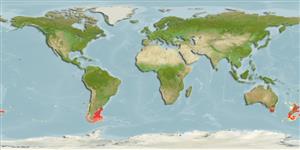Environment: milieu / climate zone / depth range / distribution range
Ecologia
marino; distribuzione batimetrica 1 - 800 m (Ref. 9563), usually 1 - 200 m (Ref. 75154). Temperate; 33°S - 60°S, 140°E - 57°W
Southwest Pacific: southern Australia and New Zealand (Ref. 9002). Southeast Pacific: Chile, including the Juan Fernandez Islands. Southwest Atlantic: Argentina.
Size / Peso / Age
Maturity: Lm ? range ? - ? cm
Max length : 65.0 cm SL maschio/sesso non determinato; (Ref. 27363); common length : 40.0 cm SL maschio/sesso non determinato; (Ref. 27363); peso massimo pubblicato: 6.0 kg (Ref. 27363); Età massima riportata: 12 anni (Ref. 31614)
Short description
Chiavi di identificazione | Morfologia | Morfometria
Spine dorsali (totale) : 6 - 7; Raggi dorsali molli (totale) : 32 - 35; Spine anali: 2; Raggi anali molli: 22 - 25.
Adults demersal on the continental shelf and upper slope (Ref. 9563). Juveniles known from surface waters, commonly with jelly fishes.
Life cycle and mating behavior
Maturità | Riproduzione | Deposizione | Uova | Fecundity | Larve
Kuiter, R.H., 1993. Coastal fishes of south-eastern Australia. University of Hawaii Press. Honolulu, Hawaii. 437 p. (Ref. 9002)
IUCN Red List Status (Ref. 130435: Version 2024-1)
Threat to humans
Harmless
Human uses
Pesca: commerciale
Strumenti
Special reports
Download XML
Fonti Internet
Estimates based on models
Preferred temperature (Ref.
123201): 4.1 - 13.7, mean 9.2 °C (based on 101 cells).
Phylogenetic diversity index (Ref.
82804): PD
50 = 0.5156 [Uniqueness, from 0.5 = low to 2.0 = high].
Bayesian length-weight: a=0.00977 (0.00534 - 0.01789), b=3.11 (2.94 - 3.28), in cm total length, based on LWR estimates for this species & (Sub)family-body (Ref.
93245).
Trophic level (Ref.
69278): 3.2 ±0.33 se; based on food items.
Resilienza (Ref.
120179): Medio, tempo minimo di raddoppiamento della popolazione 1.4 - 4.4 anni (Assuming tm=3-4).
Prior r = 0.57, 95% CL = 0.37 - 0.85, Based on 2 data-limited stock assessments.
Fishing Vulnerability (Ref.
59153): Moderate to high vulnerability (52 of 100).
Climate Vulnerability (Ref.
125649): Moderate to high vulnerability (51 of 100).
Nutrients (Ref.
124155): Calcium = 28.4 [16.5, 49.5] mg/100g; Iron = 0.453 [0.260, 0.779] mg/100g; Protein = 17.9 [16.0, 20.0] %; Omega3 = 0.722 [0.428, 1.202] g/100g; Selenium = 17.2 [8.8, 32.9] μg/100g; VitaminA = 16.4 [5.2, 51.7] μg/100g; Zinc = 0.515 [0.368, 0.739] mg/100g (wet weight);
